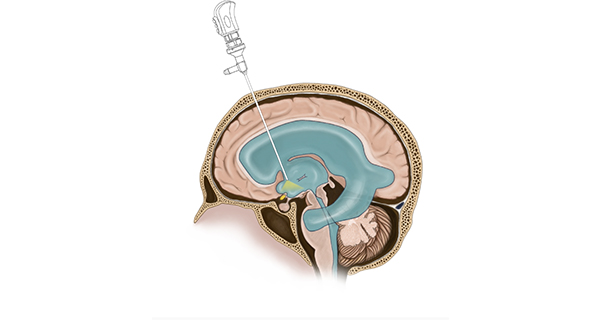
Hydrocephalus
What is Hydrocephalus?
Hydrocephalus is a condition of excess fluid on the brain. The brain and spinal cord are normally bathed by cerebrospinal fluid (CSF) which gives the brain buoyancy and acts as a shock-absorber to protect these delicate structures.

CSF is produced in fluid-filled structures called ventricles. The brain has four ventricles: two lateral ventricles connected to the third ventricle via the foramina of Munro. This drains into the fourth ventricle via the cerebral aqueduct (Aqueduct of Sylvius). The fluid then leaves the fourth ventricle, bathes the entire brain and spinal cord and is absorbed back into the blood stream via arachnoid granules along the venous sinuses.
The CSF is produced by the “choroid plexus.” This structure lines all four ventricles and produces enough fluid to cycle through the entire central nervous system at least three times per day.
Unfortunately, there is no off switch to stop this process. Hence, if there is blockage along the drainage pathway or if the fluid cannot be absorbed back into the blood, then the fluid is backed-up into the ventricles, causing enlargement – a.k.a. Hydrocephalus.
What Causes Hydrocephalus?
There are numerous causes of hydrocephalus that occur in adults. One can be born with an obstruction (aqueductal stenosis) and in utero or developmental events can result in some versions of hydrocephalus. Conversely, one can have a cerebral disease that results in hydrocephalus including meningitis, hemorrhage (brain bleed), traumatic brain injury, brain tumors or CSF spread of cancer cells (leptomeningeal carcinomatosis).
Hydrocephalus Symptoms
Symptoms of hydrocephalus range from:
- Memory difficulties
- Walking difficulties
- Incontinence
- Vision disturbances
- Headaches
- Nausea
- Vomiting
- Seizures
- Altered mental status in more acute cases
Basic brain imaging including CT scan of the head and brain MRI are necessary to make this diagnosis. Though there are some medications that can slow this fluid production, there is no medical way to stop production as of yet.
Diagnosis and Treatment
Treatment includes diversion of the CSF to other parts of the body. This can be done in a variety of methods and is tailored to the type of hydrocephalus. Hydrocephalus diagnoses include:



